BuckleBoy
Platinum Member
- Joined
- Jun 12, 2006
- Messages
- 18,132
- Reaction score
- 9,701
- Golden Thread
- 4
- Location
- Moonlight and Magnolias
- 🥇 Banner finds
- 4
- 🏆 Honorable Mentions:
- 2
- Detector(s) used
- Fisher F75, Whites DualField PI, Fisher 1266-X and Tesoro Silver uMax
- Primary Interest:
- All Treasure Hunting
Hello All,
Been busy here in Louisiana, with not a whole lot of time for digging, but I did get out for four days recently and found some pretty incredible things--including some firsts for me in 30 years of digging! If you prefer the video, here it is. Otherwise read on!
On day 1 we dug at an old site here where I've dug many good items in the past, including a whole coat of Louisiana pelican buttons, numerous Seated and Spanish silver coins, a civil war era musket and pieces of a French flintlock pistol from the early 1800s--not to mention a cannonball! The field had just been plowed and turned over, so hopes were high! It's always a weird game when iron-infested fields are plowed up. Seems like it stirs up the iron and the signals are like a nest of bees stirred up. So much interference that it's hard for a detector to "see through it." At any rate, the finds didn't all require a detector to find! Walked right up on a New York coat button as soon as I got there! Laying right on top of the ground!
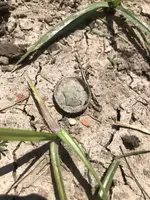
After picking through the iron for a while, I got a high tone hiding in the iron chatter and pulled out a clod of hard dirt that had a sweet silver rim showing:
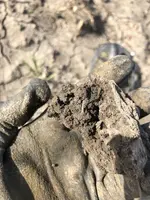
Turned out to be a good bit later of a coin than I'd thought--an 1887 Seated Dime:
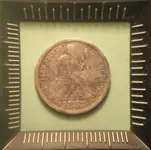
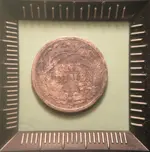
After that find, I took less than ten steps and got a scratchy, deep signal in between the nails. I dug down about a foot and saw a round disc that was the diameter of a quarter. Thinking it would be a flat button I picked it up and wiped it off. It really looked like a coin. Swiping it under the detector, it read high! Was this a two cent piece?? Or was it... a HALF CENT??
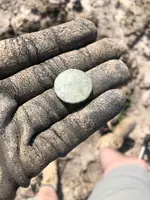
Turning the coin at an angle to the sunlight I could barely see a date--1808 or 1809!!!! Now let me just say that I've had friends that have dug half cents but I've never swung my coil over one. They weren't at all common in the 18th century "Western Frontier" of Appalachia where I grew up, and they weren't common finds in Kentucky and Indiana where I did most of my swinging before moving down here to Louisiana. Well, in Louisiana we seldom find large coppers of any sort, averaging only 1-2 per year compared to 30-50 old silver coins. The coin is indeed an 1809 classic head half cent. My first ever!
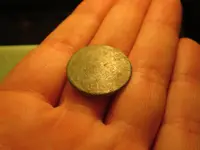
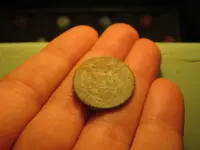
The finds continued that day with several cartridge box finials (one made of lead, one of brass), a mashed minieball, and several shield nickels. Was definitely a sweeet hunt!
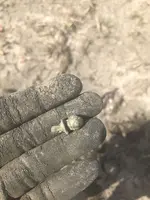
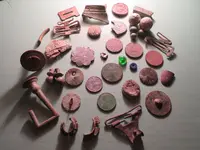
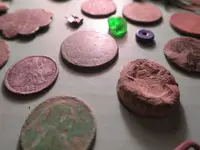
Well the next day we decided to eyeball in a site that was too "young" and too trashy to dig. Y'all know the sites...1940s and later, full of car parts, aluminum ice cube trays, caps from "Fleecy White" bottles... These sites DO often have a history in Louisiana as quarters, so they often hide older finds--but it's just not economical for us to spend our time out in the heat wearing ourselves out digging up the can slaw and trash. Far better to simply walk and eyeball and cover a lot of ground. Besides, the plow will eventually bring most of it up. In spots where great finds are made, of course, we still dig and just deal with it (I dug the site where I recovered the 1870s pistol this year, and also got a bullet mold and a great old railroad lock, for example). At any rate, we went eyeballing and spent the whole day at it, at multiple sites and found a TON of stuff: marbles, old bottles, glass stoppers, buttons, china doll parts, coins and tokens, and more. The bottles that survive are usually small ones. I was heartbroken that the straight-sided coke didn't survive. Would love to have had one in my collection!
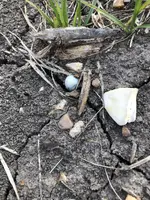
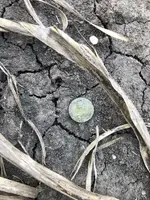
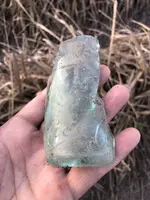
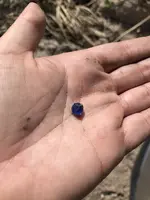
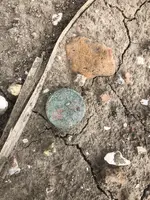
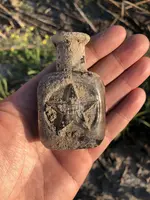
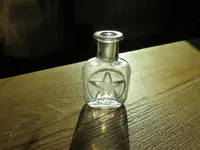
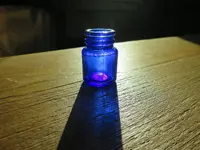
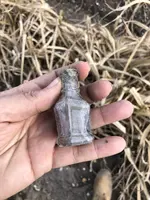
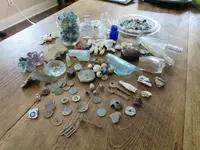
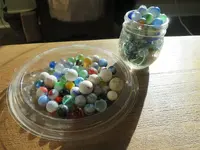
Day 3 we came back to the first site and they'd plowed it again!! It was all large, ankle-breaking chunks! So we decided to spend our day at our colonial tavern site. The tavern site hadn't been plowed or changed at all since we had been there last, but it's never a bad plan to spend a day at a site like this. This is the site that has given me the Spanish colonial cap badge, George Washington Inaugural button, one of the two, rare Planter's Bank tokens (all of which made the banner here), and probably 50 of our 100 Spanish Silvers we've recovered in the past year here--not to mention over 60 military buttons going back to colonial occupation and probably 40 early seated and capped bust coins.
It was all large, ankle-breaking chunks! So we decided to spend our day at our colonial tavern site. The tavern site hadn't been plowed or changed at all since we had been there last, but it's never a bad plan to spend a day at a site like this. This is the site that has given me the Spanish colonial cap badge, George Washington Inaugural button, one of the two, rare Planter's Bank tokens (all of which made the banner here), and probably 50 of our 100 Spanish Silvers we've recovered in the past year here--not to mention over 60 military buttons going back to colonial occupation and probably 40 early seated and capped bust coins. 
As we suspected, targets were thin, but we got some lead pieces, small brass, one nickel, and I dug a weird piece made of gold-plated brass with a tiny silver flower attached to it:
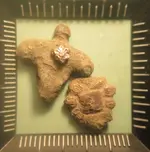
Then as it got late in the day I heard a faint beep and saw in the side wall of the cane row the unmistakable glint of gold! Getting down on the level with it I could tell that it was engraved!
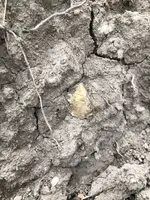
No clue what this piece is, but I like it! I heated and unbent it at home. Wonder if it's a suspender clip? Strange thing is that it's engraved on both sides (FYI Shangalang pulled a colonial era engraved silver piece of jewelry out of this tavern site back in 2013!):
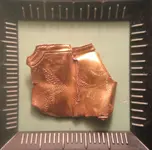
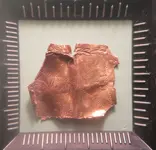
On Day 4 I went in a different direction up to a great site that gave Shangalang his Texas Republic Navy button, me my "cast c" cavalry button, a half an eagle breastplate and handfulls of coins and civil war relics. The site had been turned but the weather has been so rainy and nasty here that our window before planting was only one day.
So I decided to get in there and get as much out of the ground as I could before we had to wait until October. As usual, the minieballs started coming up:
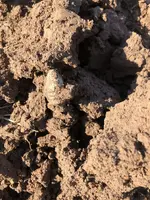
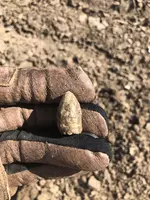
also got a few carved bullets, flat buttons, and lots of melted lead. One random Buffalo nickel. Pistol bullet, spur piece...
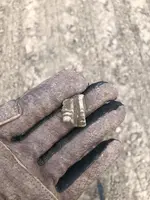
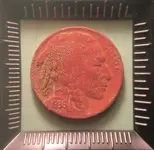
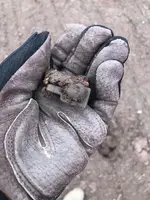
Also got this weird mystery item. Brass that was once gold gilded:
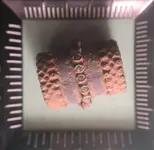
Then I got a signal that read a solid 19 on the F75. That's a foil number, but the ground is really bad in this site (minieballs were reading in the 20s so...). When I flopped it out I was absolutely STUNNED. It was GOLD!!
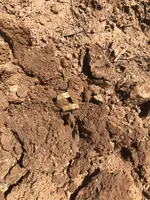
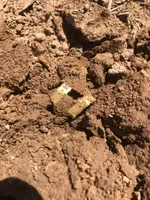
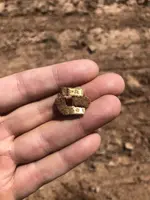
At that point I had idea what it was. It was obviously high karat gold, so I carefully bent it back into shape in the field. The item was covered with strange symbols that made me think at first it was some sort of fraternal item. What particularly got me was the "MO" on it. Obviously that wasn't a word.
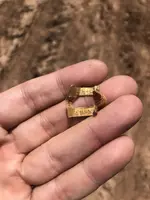
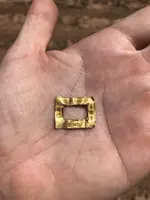
Well, after I could see it more clearly it dawned on me that the letters were Old English Gothic Black Letter:
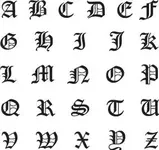
And once I identified each letter, plain as day, it said "IN * ME MO RY * OF"
Armed with that knowledge, I started searching and as it turns out this is a piece of mourning jewelry (a brooch) dating between 1820 and 1840 most likely. I was able to find a VERY similar non-dug example which can be seen below. A lock of the deceased's hair wouldve been cleaned and braided, and placed under a crystal or faceted piece of glass in the brooch. The one I dug is only the front, missing the border, the crystal, and the pin back. (Although you can tell where they were braised on.) It'd be a dream to recover the back of this, which was probably a flat piece of gold with the pin braised on. Reason why I want the back is that it was likely engraved with a name and dates.
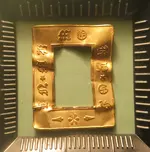
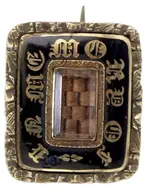
Mourning jewelry was often worn long after the mourner stopped wearing their black clothing--often the mourners wore this type of jewelry their entire life. So this was a very special piece, which had a great deal of care in its construction (the washing and careful braiding of the deceased's hair; the engraving of the back). Although some might find this practice somewhat creepy, I think it's rather beautiful--to carry a piece of the person you loved with you to remember them by. So I'm just absolutely thrilled with this find. Have never seen one posted here on TreasureNet before--likely because these were such special pieces they were seldom lost or tossed. But I'm just thrilled. Now that we have cleaned out a lot of our sites and are digging iffy, jumpy, and scratchy signals I'm hoping that the elusive gold coin is finally in the forecast for me. Let's hope that 2021 continues to be a Gold year!
Best Wishes,
Buckleboy
Been busy here in Louisiana, with not a whole lot of time for digging, but I did get out for four days recently and found some pretty incredible things--including some firsts for me in 30 years of digging! If you prefer the video, here it is. Otherwise read on!
On day 1 we dug at an old site here where I've dug many good items in the past, including a whole coat of Louisiana pelican buttons, numerous Seated and Spanish silver coins, a civil war era musket and pieces of a French flintlock pistol from the early 1800s--not to mention a cannonball! The field had just been plowed and turned over, so hopes were high! It's always a weird game when iron-infested fields are plowed up. Seems like it stirs up the iron and the signals are like a nest of bees stirred up. So much interference that it's hard for a detector to "see through it." At any rate, the finds didn't all require a detector to find! Walked right up on a New York coat button as soon as I got there! Laying right on top of the ground!

After picking through the iron for a while, I got a high tone hiding in the iron chatter and pulled out a clod of hard dirt that had a sweet silver rim showing:

Turned out to be a good bit later of a coin than I'd thought--an 1887 Seated Dime:


After that find, I took less than ten steps and got a scratchy, deep signal in between the nails. I dug down about a foot and saw a round disc that was the diameter of a quarter. Thinking it would be a flat button I picked it up and wiped it off. It really looked like a coin. Swiping it under the detector, it read high! Was this a two cent piece?? Or was it... a HALF CENT??

Turning the coin at an angle to the sunlight I could barely see a date--1808 or 1809!!!! Now let me just say that I've had friends that have dug half cents but I've never swung my coil over one. They weren't at all common in the 18th century "Western Frontier" of Appalachia where I grew up, and they weren't common finds in Kentucky and Indiana where I did most of my swinging before moving down here to Louisiana. Well, in Louisiana we seldom find large coppers of any sort, averaging only 1-2 per year compared to 30-50 old silver coins. The coin is indeed an 1809 classic head half cent. My first ever!


The finds continued that day with several cartridge box finials (one made of lead, one of brass), a mashed minieball, and several shield nickels. Was definitely a sweeet hunt!



Well the next day we decided to eyeball in a site that was too "young" and too trashy to dig. Y'all know the sites...1940s and later, full of car parts, aluminum ice cube trays, caps from "Fleecy White" bottles... These sites DO often have a history in Louisiana as quarters, so they often hide older finds--but it's just not economical for us to spend our time out in the heat wearing ourselves out digging up the can slaw and trash. Far better to simply walk and eyeball and cover a lot of ground. Besides, the plow will eventually bring most of it up. In spots where great finds are made, of course, we still dig and just deal with it (I dug the site where I recovered the 1870s pistol this year, and also got a bullet mold and a great old railroad lock, for example). At any rate, we went eyeballing and spent the whole day at it, at multiple sites and found a TON of stuff: marbles, old bottles, glass stoppers, buttons, china doll parts, coins and tokens, and more. The bottles that survive are usually small ones. I was heartbroken that the straight-sided coke didn't survive. Would love to have had one in my collection!











Day 3 we came back to the first site and they'd plowed it again!!
 It was all large, ankle-breaking chunks! So we decided to spend our day at our colonial tavern site. The tavern site hadn't been plowed or changed at all since we had been there last, but it's never a bad plan to spend a day at a site like this. This is the site that has given me the Spanish colonial cap badge, George Washington Inaugural button, one of the two, rare Planter's Bank tokens (all of which made the banner here), and probably 50 of our 100 Spanish Silvers we've recovered in the past year here--not to mention over 60 military buttons going back to colonial occupation and probably 40 early seated and capped bust coins.
It was all large, ankle-breaking chunks! So we decided to spend our day at our colonial tavern site. The tavern site hadn't been plowed or changed at all since we had been there last, but it's never a bad plan to spend a day at a site like this. This is the site that has given me the Spanish colonial cap badge, George Washington Inaugural button, one of the two, rare Planter's Bank tokens (all of which made the banner here), and probably 50 of our 100 Spanish Silvers we've recovered in the past year here--not to mention over 60 military buttons going back to colonial occupation and probably 40 early seated and capped bust coins. 
As we suspected, targets were thin, but we got some lead pieces, small brass, one nickel, and I dug a weird piece made of gold-plated brass with a tiny silver flower attached to it:

Then as it got late in the day I heard a faint beep and saw in the side wall of the cane row the unmistakable glint of gold! Getting down on the level with it I could tell that it was engraved!

No clue what this piece is, but I like it! I heated and unbent it at home. Wonder if it's a suspender clip? Strange thing is that it's engraved on both sides (FYI Shangalang pulled a colonial era engraved silver piece of jewelry out of this tavern site back in 2013!):


On Day 4 I went in a different direction up to a great site that gave Shangalang his Texas Republic Navy button, me my "cast c" cavalry button, a half an eagle breastplate and handfulls of coins and civil war relics. The site had been turned but the weather has been so rainy and nasty here that our window before planting was only one day.

So I decided to get in there and get as much out of the ground as I could before we had to wait until October. As usual, the minieballs started coming up:


also got a few carved bullets, flat buttons, and lots of melted lead. One random Buffalo nickel. Pistol bullet, spur piece...



Also got this weird mystery item. Brass that was once gold gilded:

Then I got a signal that read a solid 19 on the F75. That's a foil number, but the ground is really bad in this site (minieballs were reading in the 20s so...). When I flopped it out I was absolutely STUNNED. It was GOLD!!



At that point I had idea what it was. It was obviously high karat gold, so I carefully bent it back into shape in the field. The item was covered with strange symbols that made me think at first it was some sort of fraternal item. What particularly got me was the "MO" on it. Obviously that wasn't a word.


Well, after I could see it more clearly it dawned on me that the letters were Old English Gothic Black Letter:

And once I identified each letter, plain as day, it said "IN * ME MO RY * OF"
Armed with that knowledge, I started searching and as it turns out this is a piece of mourning jewelry (a brooch) dating between 1820 and 1840 most likely. I was able to find a VERY similar non-dug example which can be seen below. A lock of the deceased's hair wouldve been cleaned and braided, and placed under a crystal or faceted piece of glass in the brooch. The one I dug is only the front, missing the border, the crystal, and the pin back. (Although you can tell where they were braised on.) It'd be a dream to recover the back of this, which was probably a flat piece of gold with the pin braised on. Reason why I want the back is that it was likely engraved with a name and dates.


Mourning jewelry was often worn long after the mourner stopped wearing their black clothing--often the mourners wore this type of jewelry their entire life. So this was a very special piece, which had a great deal of care in its construction (the washing and careful braiding of the deceased's hair; the engraving of the back). Although some might find this practice somewhat creepy, I think it's rather beautiful--to carry a piece of the person you loved with you to remember them by. So I'm just absolutely thrilled with this find. Have never seen one posted here on TreasureNet before--likely because these were such special pieces they were seldom lost or tossed. But I'm just thrilled. Now that we have cleaned out a lot of our sites and are digging iffy, jumpy, and scratchy signals I'm hoping that the elusive gold coin is finally in the forecast for me. Let's hope that 2021 continues to be a Gold year!
Best Wishes,
Buckleboy
Last edited:
Upvote
48









